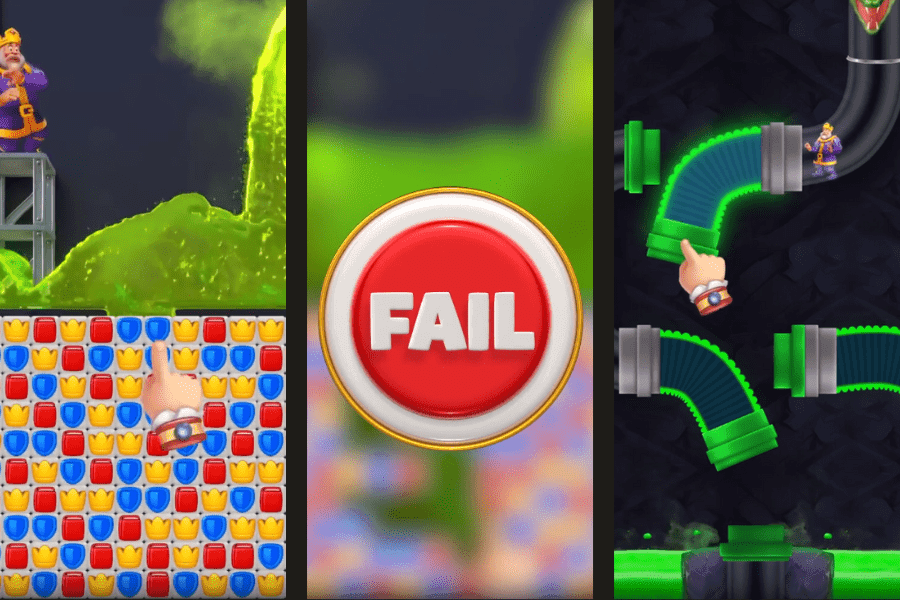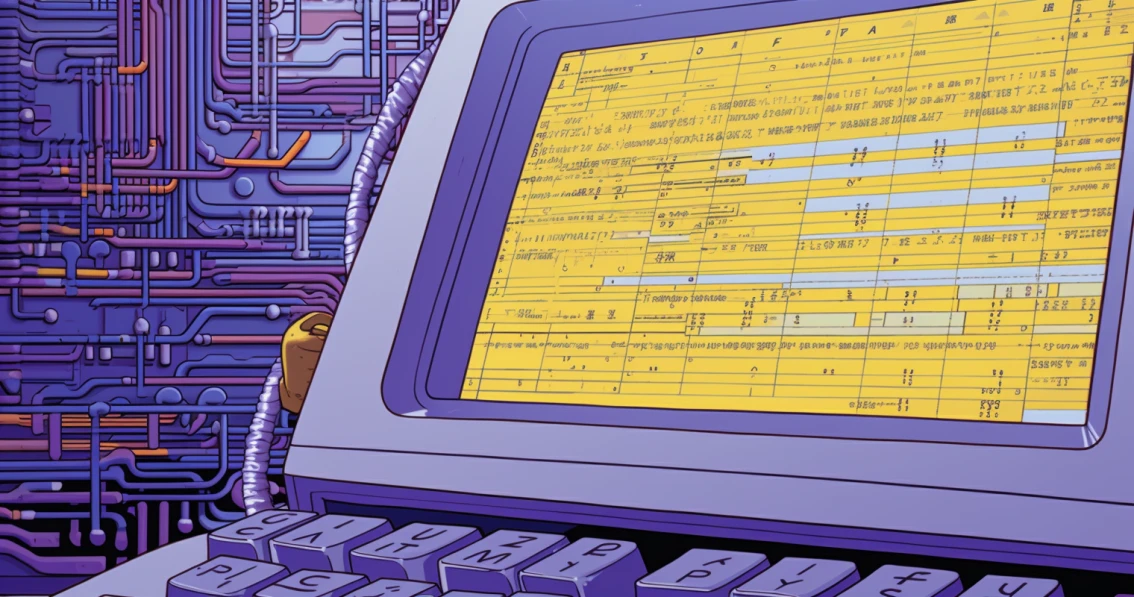Mobile game ads are everywhere. You’ve seen them between levels, on YouTube, in your feed—sometimes hilarious, sometimes misleading, sometimes just plain weird.
But behind those wild videos is a massive industry powered by data, creativity, and billions of dollars. Whether you’re in the gaming world or just wondering why that puzzle ad looks nothing like the game, this guide will give you the full picture.
As a marketing agency that actually makes those ads, we’ll break down how mobile game ads work, why some of them lie, how they help games grow, and how they actually make money.
Plus, we’ll show you some real examples, explain the tricks behind the scenes, and even share tips on what makes a great mobile game ad.
1. What Are Mobile Game Ads?
If you’ve played even one mobile game or scrolled through TikTok for five minutes, you’ve seen mobile game ads. They pop up between levels, disguise themselves as TikToks, or slide into your YouTube pre-roll like they own the place.
Some are sleek and polished. Others look like they were made in MS Paint on purpose. Either way—they’re all trying to get you to do one thing: download a game.

Where You’ll See Them
Mobile game ads show up all over the internet—and often inside other mobile games. Here are the most common spots:
- Inside other games (think: “watch this to get 2x coins”)
- On TikTok, Instagram, Facebook, and YouTube
- In other apps, especially free ones
- Embedded in mobile websites or search results
- Occasionally, as part of influencer content or sponsored videos
They’re built to grab your attention fast. Sometimes in fun ways. Sometimes in… really weird ways.
Types of Mobile Game Ads You’ll Run Into
Let’s break down the formats you’ve definitely seen, even if you didn’t know what they were called.
Playable Ads
Playable ads are mini, interactive demos where you get to try the game before downloading. Tap to jump, swipe to solve the puzzle, or just fail repeatedly while the timer ticks down.
They’re surprisingly effective because they mimic actual gameplay. Check out these examples of playable ads to get the idea of what works best.

Rewarded Video Ads
You’ve probably watched a rewarded video ad in exchange for some in-game loot—extra lives, coins, or a power-up. They’re optional but hard to resist, especially if you’re one gem away from upgrading your castle.
Interstitial Ads
Interstitial ads are full-screen ads that take over your app between levels or actions. They’re short but unskippable for a few seconds—and they usually follow a “hook → gameplay clip → call to action” structure.
Banner Ads
Banner ads are the quiet little ads chilling at the top or bottom of your game screen. Not flashy, but they still rack up impressions.

UGC-Style Mobile Game Ads
Think TikToks that look like organic content but are actually ads. These often feature casual creators playing the game, giving opinions, or narrating in that classic TikTok voice.
Influencer Ads
Influencer ads are promoted directly by streamers, YouTubers, or TikTokers who either genuinely like the game—or got paid well to say they do.
Either way, they’re designed to feel more trustworthy and “native” to your feed.
How You Influence What Ads Show Up
Here’s something most people don’t realize: you help decide which mobile game ads stay and which ones disappear.
Every time you:
- Watch an ad all the way through
- Tap the screen during a playable
- Install the game being advertised
…you’re sending a signal back to the ad platform (like Meta or TikTok) that this ad works. That feedback loop tells marketers, “Hey, this creative is a winner—scale it up!”
And when an ad flops (low views, no installs, bad engagement)? It gets killed. Fast.
So yeah—if you’ve ever complained, “Why do I keep seeing this same weird ad?”, the answer might just be: because a lot of people are clicking on it.

2. The Rise of Fake Mobile Game Ads
You’ve seen them.
Ads where a stick figure fails a puzzle in the dumbest way possible. Or an ad that makes a simple game look like an epic decision-making adventure with lava traps and treasure chests.
Then you download the game… and it’s match-3.
So, yeah. Fake mobile game ads are a thing—and they’re not going away anytime soon.
What Makes a Mobile Game Ad “Fake”?
A mobile game ad is considered fake when it doesn’t accurately represent the actual game you’ll download.
That could mean:
- Showing a totally different gameplay style
- Adding storylines, puzzles, or characters that don’t exist
- Overhyping drama, stakes, or features that are barely there
But here’s the wild part: a lot of these fake ads technically aren’t breaking the rules. They might show a “bonus mode” that’s buried 10 levels deep. Or they might use stylized visuals to suggest an experience, even if the real game feels totally different.

Why Developers (and Marketers) Keep Making Them
Short answer? They work.
Marketers are trying to drive installs at the lowest cost possible (that’s called CPI—Cost Per Install).
To do that, they test hundreds of ads and pick the ones that get the best:
- CTR (click-through rate)
- Watch time
- Install rate
And guess what? Ads that make you curious—even if they’re misleading—outperform the “honest” ones way too often.
Here’s the thought process behind it:
- Fake ads = more clicks
- More clicks = lower ad costs
- Lower ad costs = better margins
- Better margins = more scale
And so the cycle continues. It’s not necessarily game developers scheming in the shadows—it’s the UA (user acquisition) teams like ours testing what gets results.
The Psychology Behind Mobile Game Ads
Fake mobile game ads tap into a few tried-and-true psychological tricks. They’re designed to poke your brain just enough to make you click:
The Curiosity Gap
You see something confusing or dramatic—and your brain wants to know more. The ad doesn’t give you all the answers, so you click to “solve” it.
Frustration Loops
A character keeps failing an obvious puzzle (“No! Pull the other pin!!”). You think, “I could do that better.” That’s the whole point. You click just to prove it.
Power Fantasy Hooks
Ads show you going from broke to billionaire, outsmarting your enemies, or making perfect choices every time. Even if the real game has none of this, the hook still reels people in.
These tactics aren’t unique to mobile games—but mobile ads often take them to the most ridiculous extreme.

How This Impacts Players
Let’s be honest—players are in on the joke at this point.
Reddit threads, TikTok comment sections, and YouTube reaction videos have turned fake mobile game ads into a genre of entertainment. People love to roast them, react to them, and even download the games just to see how far off the ad was.
But it’s not all laughs.
Some players feel genuinely tricked or annoyed.
There’s backlash, low app store ratings, and plenty of mobile game ads memes mocking the worst offenders.
Still, as long as the numbers keep working out for marketers, you’re going to keep seeing these ads—especially the ones that make you say, “Ugh… I kinda want to try this.”
3. Mobile Game Ads as a Growth Tool (Paid User Acquisition)
Mobile game ads aren’t just quirky or annoying—they’re powerful business tools. In fact, paid ads are the single biggest driver of growth for most mobile games.
Let’s talk about what goes into user acquisition for mobile games, why it matters, and what makes the process tick.
What Is Paid User Acquisition in Mobile Gaming?
Paid user acquisition (UA) simply means paying to bring new users (players) into your game through ads.
Here’s how it works:
- You create mobile game ads.
- You run these ads across ad networks (like Meta, Google Ads, or Unity Ads).
- Players see the ads and download the game.
- You pay based on cost per install (CPI)—meaning you only spend money when someone actually installs your game.
CPI is a key metric because it directly shows how cost-effective your ad campaign is. A lower CPI generally means your ad strategy is effective, while a high CPI suggests you might need better targeting, creatives, or a fresh approach.
Paid UA is absolutely critical because it’s scalable.
Organic growth (users finding your game naturally) is great but usually limited. Paid ads, on the other hand, can bring in thousands—or millions—of new players fast. That’s why successful mobile games often have hefty ad budgets.
The Ad Creation Process
Creating mobile game ads isn’t random. It’s a detailed, iterative process:
Step 1: Brainstorming and Scripting
First, we come up with hooks—eye-catching, curiosity-driven ideas to grab your attention in the first few seconds.
Step 2: Production
Once the hook is ready, we move into actual production—animation, video editing, sound design, and voiceover work. Ads are often short, so every second counts.
Step 3: Testing and Iteration
Ads rarely launch alone. Usually, we test multiple variations simultaneously (A/B testing) to see what resonates most.
For example, we might try different opening visuals, color schemes, or characters.
Step 4: Scaling and Retiring
When an ad clearly wins (high CTR and low CPI), we scale it up—meaning it’s shown to millions more. But even great ads eventually wear out (called creative fatigue). At that point, we retire them, and new ads step up to replace them.
Creative Fatigue and Iteration
Creative fatigue happens when people see the same ad repeatedly and stop responding. Clicks drop, CPIs climb, and ROI suffers. To avoid this, we constantly test new ads and refresh older ones.
Some platforms and tools help marketers with this, including:
- Meta’s Dynamic Creative Testing
- Google’s App Campaigns (formerly UAC)
- Creative testing platforms like Luna Labs or CLIK Dashboard
These tools let marketers rapidly test hundreds of ad variations—changing backgrounds, characters, hooks, or even tiny details like button colors—to see what drives the most installs.
How Targeting Works
Mobile game ads aren’t randomly shown to everyone—they’re carefully targeted to different audience segments. Ad networks use massive amounts of data and advanced machine learning to match ads with the right people.
Ads can be targeted based on:
- Behavior (what games people already play, how often they play, spending habits)
- Demographics (age, gender, location)
- Device type (Android or iOS, phone model, performance specs)
- Interests (casual puzzle players vs. hardcore RPG gamers)
- Geography (country or region-specific targeting)
Advanced machine learning algorithms track responses in real-time, optimizing which ads to show and who to show them to. That’s why sometimes ads feel eerily accurate—and why they seem to follow you around the internet.
Top Ad Networks & Platforms
Not all ad networks are created equal. Some are better for acquiring players than others.
Here are some major players marketers rely on:
- Meta (Facebook/Instagram): Huge audience, precise targeting capabilities, best for broad reach.
- Google Ads: Great for large-scale, automated campaigns across Android devices and YouTube.
- Unity Ads: Excellent for targeting dedicated gamers, popular for rewarded video ads.
- Applovin: Strong in mobile-first, hyper-casual games, heavy on automation.
- IronSource: Popular for rewarded ads and mediation (managing multiple ad networks at once).
- TikTok Ads: Best for UGC-style ads, younger demographics, high virality potential.
Each platform has strengths and weaknesses, and marketers typically use several to get the best results.
Regional Differences in Ad Performance
An ad that crushes it in the U.S. might flop in Japan or Brazil. Cultural differences matter—a lot.
For example:
- Asia (particularly Korea, Japan, China): Ads with emotional storytelling, visually rich graphics, or dramatic narratives often perform best.
- Western markets (U.S., Europe): Humor, sarcasm, relatable struggles, or quick punchy ads tend to win out.
- Brazil & Latin America: Ads highlighting community and social play tend to resonate deeply.
The trick is adapting creatives to local tastes. Great UA teams don’t just translate—they localize concepts, visuals, and humor to connect authentically with each region.

What Makes a Mobile Game Ad Actually Work?
Ultimately, great mobile game ads share a few common traits:
- Strong Hook: A gripping opening that makes you pause mid-scroll.
- Emotional Triggers: Excitement, humor, curiosity, or even frustration.
- Visual Clarity: Immediate understanding of what’s going on (or intriguing mystery).
- Good Pacing: Quick cuts and fast action—no boredom allowed.
- Clear Call-to-Action (CTA): Always end with a direct push (“Install now,” “Play free”).
Nail those elements, and you’ve got an ad that not only grabs attention but actually drives installs at a low cost.
4. Monetizing Apps with Mobile Game Ads (Ad Revenue Model)
Ever wonder how all those free games can afford to stay free? Many mobile games don’t make money by selling gems, coins, or special upgrades. Instead, their entire revenue comes from mobile game ads—by showing you ads, they’re literally funding your gameplay.
Here’s exactly how that works.

How Mobile Games Make Money from Ads
If you’ve ever played a simple puzzle or hyper-casual game and watched an ad to get extra moves, you’re part of the system.
The game developer earns money every time you:
- Watch an ad (even partially)
- Interact with an ad (tapping, playing a mini-game, or clicking a link)
- Install another game from an ad you saw
This means that games which don’t sell premium features or items can still make good revenue just from showing ads. In fact, for some games, ad revenue is their main—or only—income source.
Different Monetization Models
There are a few common ways games monetize through ads, each with its own approach:
- Rewarded video ads
- Interstitial ads
- Banner ads
- Offerwalls
Rewarded Video Ads
Rewarded ads are hugely popular because they offer you something valuable (like an extra life, more coins, or a second chance) for watching a short video. Developers like them because players choose to watch them—meaning engagement (and revenue) is high.
Interstitial Ads
These ads interrupt gameplay briefly—usually between levels or rounds. Because they’re unavoidable, developers know they’ll reliably get views (and thus revenue), even though they sometimes annoy players.
Banner Ads
These small, persistent ads are shown at the top or bottom of the screen during gameplay. They typically earn less per view, but they’re easy to implement and can quietly rack up revenue with minimal disruption.
Offerwalls
These are special sections where you complete tasks (like surveys, installs, or signing up for trials) in exchange for big in-game rewards. Developers earn significantly more per interaction here, but fewer players actually use them.
All these ad types are measured with eCPM (effective cost per thousand impressions). A higher eCPM means the developer makes more money from every thousand ad views. Rewarded video usually has the highest eCPM, interstitials sit in the middle, and banners usually have the lowest.
Which Games Use This Model Best?
Hyper-casual games dominate this monetization model. Think about games like Helix Jump, Crowd City, or Crossy Road. They’re built around short sessions—quick, easy gameplay you pick up for a few minutes at a time.
Why does this model suit hyper-casual games so well?
- Short gameplay sessions mean many ad impressions quickly.
- High player turnover (churn) means developers need immediate revenue rather than long-term player spending.
- Simple gameplay mechanics easily accommodate ads without frustrating players too much.
In fact, successful hyper-casual games often have minimal content but still make millions of dollars purely from ad revenue. They’re quick to make, quick to play, and quick to monetize.
5. Examples of Mobile Game Ads That Work
We’ve talked a lot about how mobile game ads function—but let’s see them in action. Some are hilarious, some are frustrating, and some are just really good at showcasing actual gameplay.
Here’s what makes each type tick:
Funny or Misleading Ads: When Mobile Game Ads Go Viral

Evony: The King’s Return
Evony is notorious for showing ads with hyper-casual gameplay: armies endlessly charging at the player, who defeats enemies with a simple tap.
But here’s the catch—Evony is actually a classic mid-core strategy game.
The actual gameplay involves resource management, alliance building, and strategic planning, nothing like the frenetic battles in the ads.
Yet these misleading scenarios capture attention, boost curiosity, and drive installs—making Evony one of the most recognizable examples of fake ads.

Royal Match & Homescapes
These two match-3 puzzle games made the “pin-pulling” scenario famous—Royal Match with its character King Robert constantly stuck in dangerous situations, and Homescapes presenting a player failing to save a house or character from disaster.
We even wrote a full article on Homescapes’ misleading ads.
These “fail ads” use the frustration loop brilliantly—viewers think, “I could easily solve this!”—which compels them to click. Even though neither game primarily features these mechanics, the ads remain popular because they consistently grab attention and drive conversions.

Hero Wars
Hero Wars ads notoriously depict ultra-simple puzzles that players fail spectacularly, prompting immediate frustration and curiosity. The actual game is a mid-core RPG, not a casual puzzle game.
These intentionally misleading scenarios hook players with that “I can do better” mentality, which significantly lowers their CPI and boosts installs—even if players feel misled after downloading.
Genuinely Great Ads: Keeping It Real
Fake ads aren’t the only ads that work. Some of the most effective ads are completely authentic, showcasing actual gameplay and keeping promises made in the ads.

Subway Surfers
One of the biggest mobile game hits ever, Subway Surfers ads do one simple thing incredibly well—they showcase the actual gameplay, nothing more, nothing less.
Bright colors, clear objectives, and a fast pace perfectly illustrate the fun players can expect. This genuine transparency builds trust, reduces bounce rates, and maintains high engagement.
Tiles Hop: EDM Rush
Another great example is Tiles Hop.
Its playable ads let you drag a ball to bounce on tiles in sync with popular music. With clear gameplay and the instantly recognizable music (like “How You Like That” by Blackpink), these ads quickly resonate with viewers. They effectively showcase the best feature of the game—music-driven gameplay—increasing installs significantly.
UGC and Influencer-Style Ads: Why They Dominate in 2025
User-generated content (UGC) and influencer-style ads have exploded, especially on platforms like TikTok and Instagram Reels. They feel authentic, relatable, and trustworthy—exactly what mobile gamers want today.
Monopoly GO
Monopoly GO’s ads combine a relatable millennial sharing his genuine experience with gameplay footage. He emphasizes familiarity, saying if you liked classic Monopoly, you’ll love Monopoly GO.
This authentic style builds immediate trust, resonating strongly with people who appreciate personal recommendations rather than polished studio ads.
Royal Match
In Royal Match’s UGC ads, a younger player praises the absence of intrusive ads while enthusiastically showcasing gameplay—especially mini-games, rather than the core match-3 mechanic.
This authentic, relatable style helps viewers feel connected and more likely to convert. Ending with a friendly, clear CTA boosts installs even more.
Toon Blast
Toon Blast takes influencer-style ads to another level by featuring recognizable celebrities.
In one example, Justin Guarini casually talks about discovering and playing Toon Blast. This “Cameo-style” ad is laid-back and believable, making viewers think, “If it’s good enough for a celebrity, it’s probably good enough for me!” The relatable vibe drives installs by leveraging social proof effectively.
Our Perspective (Udonis Insights)
At Udonis, we’ve run thousands of mobile game ad campaigns, and here’s what consistently works:
- Authenticity wins long-term: Genuinely honest ads like Subway Surfers have staying power and build loyalty.
- UGC and influencer content outperform heavily-produced ads: Ads that feel authentic, casual, and relatable consistently show better engagement rates.
- Fake ads do drive installs, but with risk: Misleading ads can deliver low CPIs initially, but can lead to negative user feedback, lower retention, and long-term brand damage.
- Playable ads for hyper-casual games are highly effective: Games like Tiles Hop that let users experience actual gameplay before installing consistently show higher conversion rates and lower costs per install.

6. Tips for Making a Great Mobile Game Ad
Now that you understand how mobile game ads work, you’re probably thinking: “How can I use this information?”
Well, whether you’re a developer looking to boost your game’s performance or you’re just someone who wonders why these ads keep chasing you, these quick tips will give you actionable insights.
If You’re a Developer or Marketer
You already know creating mobile game ads is competitive. Here’s what you absolutely have to nail to stay ahead:
- Strong hook in the first 3 seconds: The first few moments determine if viewers scroll past or click. Make it visually exciting, curious, or relatable immediately.
- Test everything: Colors, text, animation styles, voiceovers—every tiny detail matters. Continuous A/B testing helps find the ads that truly resonate.
- Use motion to grab attention: Static images won’t cut it anymore. Videos, animations, and interactive playable ads consistently outperform static creatives.
- Localize your ads: Don’t just translate—localize. Different countries respond to different humor, visuals, and even gameplay styles. Tailoring creatives specifically to top markets boosts your install rates significantly.
If You’re Just Curious or Annoyed by the Ads
Ever wonder why a particular ad follows you everywhere or why you keep seeing weird puzzles you’ll never play?
Here’s what’s happening behind the scenes:
- You’re being targeted because of your behavior: Games you’ve played, ads you’ve clicked, videos you’ve watched—these behaviors shape what ads show up for you.
- Ads are chosen by algorithms: Platforms like Meta or TikTok use machine learning to predict what you might like. Even your location and device can affect ad choices.
- Your interactions shape future ads: Clicking on an ad, watching a video all the way through, or installing a game sends a message—“More ads like this one, please!” If you ignore or close them quickly, that message is, “Not interested, try again.”
Understanding this can help you decode the ad madness. And next time an annoying ad pops up? You’ll know exactly why it’s there.
7. The Future of Mobile Game Advertising
Mobile game ads never stay the same for long—they keep adapting, getting smarter, and finding new ways to reach players.
As we look ahead, some exciting new trends are emerging that could completely change the way ads are created and delivered. Let’s explore what the future holds.
Short-form UGC Ads Will Continue to Rise
User-generated content is already big—but it’s about to get even bigger.
Expect to see more short, authentic clips from real players and micro-influencers that feel just like regular content on TikTok or Instagram Reels. These ads feel less intrusive, are highly relatable, and capture attention in a way that traditional polished ads just can’t match.
AI-generated Ads Are Taking Over
AI is starting to revolutionize ad creation and testing.
Marketers can now use AI tools to automatically produce hundreds or even thousands of different ad variations, tweaking visuals, soundtracks, and gameplay clips on the fly.
This rapid experimentation will help marketers discover exactly what resonates with players—without breaking the bank on expensive production.

Ads as Mini-stories: Narrative Storytelling
Expect mobile game ads to lean more into storytelling, turning ads into mini-series featuring characters or ongoing narratives.
Instead of isolated 15-second clips, these ads will engage players across multiple short episodes, building anticipation and deeper emotional connections.
Players might even start looking forward to the next ad—which is a marketer’s dream scenario.
Real-time Personalized Ads That Understand You Better
The future of mobile game advertising will be hyper-personalized. Ads will soon adapt in real-time based on your recent gaming sessions, your mood, or even the type of content you’re currently enjoying.
Imagine an ad knowing exactly when you need a pick-me-up, a laugh, or an exciting challenge.
Creepy or cool? Probably a bit of both.
8. Privacy, Tracking, and Apple’s ATT Shake-up
Apple’s App Tracking Transparency (ATT) was a game changer. By allowing users to opt-out of cross-app tracking, Apple made it much harder for marketers to track user behavior and serve highly targeted ads. The shift caused major disruptions in how mobile games attract new players.
Now, marketers are adapting by embracing Apple’s SKAdNetwork (SKAN), which provides anonymized performance data.
While this offers less detail than before, it’s enough for basic campaign optimization.
Additionally, developers are leaning more heavily into contextual targeting, matching ads to specific apps or content types, rather than relying on detailed user profiles. This shift has also led to rising ad costs, as marketers must reach broader audiences to maintain performance.
9. What Will Replace the “Fake” Mobile Game Ad Trend
Players are becoming increasingly skeptical of fake ads, and the industry will inevitably shift away from them.
Here are a few potential directions mobile game ads might take next:

Authentic Gameplay Showcases
As trust becomes critical, expect to see a rise in ads that clearly and honestly showcase actual gameplay. Proven hits like Subway Surfers have already demonstrated the long-term success of straightforward, transparent ads.
Humorous and Relatable UGC
Funny, quirky content from real players will likely replace the misleading style currently common in fake ads. These ads are more engaging, more shareable, and can create positive connections with viewers rather than frustration.
Live Events and Interactive Trailers
Casual and mid-core games might increasingly turn to live-streamed events, interactive trailers, or game announcements to generate excitement. Rather than relying solely on quick, flashy ads, these strategies build deeper player engagement and foster a sense of community.
10. Impact of Mobile Game Ads on the Gaming Industry
Mobile game ads aren’t just a side hustle—they’re the engine driving the entire mobile gaming ecosystem. From launching new titles to sustaining long-term engagement, advertising is the lifeblood that fuels growth and profitability.
In 2024, the mobile gaming industry generated approximately $92 billion in revenue, accounting for nearly half of the global gaming market. A significant portion of this revenue stems from advertising efforts, with studios investing heavily in user acquisition (UA) campaigns to capture and retain players. (Newzoo, 2025)
The scale of investment is staggering.
In 2024, the number of mobile game advertisers exceeded 250,000, marking a 60.4% increase from the previous year. Additionally, mobile game creatives grew by 15.4%, surpassing 4.5 million. These figures underscore the increasing reliance on advertising for mobile game success. (Social Peta, 2025)
Behind these numbers lies a complex adtech infrastructure.
The global AdTech market was valued at $876.21 billion in 2024 and is projected to grow to $986.87 billion in 2025. This ecosystem encompasses a myriad of platforms and technologies that enable precise targeting, real-time bidding, and performance tracking, all crucial for optimizing ad spend and maximizing return on investment.
In essence, mobile game advertising isn’t just about promoting games—it’s about sustaining an entire industry. Without it, many of the free-to-play experiences we enjoy wouldn’t exist.
Final Thoughts on Mobile Game Ads
Let’s be honest—mobile game ads can be a mixed bag. Sometimes they’re entertaining, other times they’re misleading, and occasionally they’re downright annoying. But despite the frustration, they play a major role in the gaming industry.
These ads fund the development of games, allowing developers to offer free content while still generating revenue. They also provide players with a glimpse into the gaming industry’s marketing strategies, revealing trends, player preferences, and the competitive nature of the market.
If you need any help with creating mobile game ads and running user acquisition campaigns, reach out – it’s what we do best!







Comments